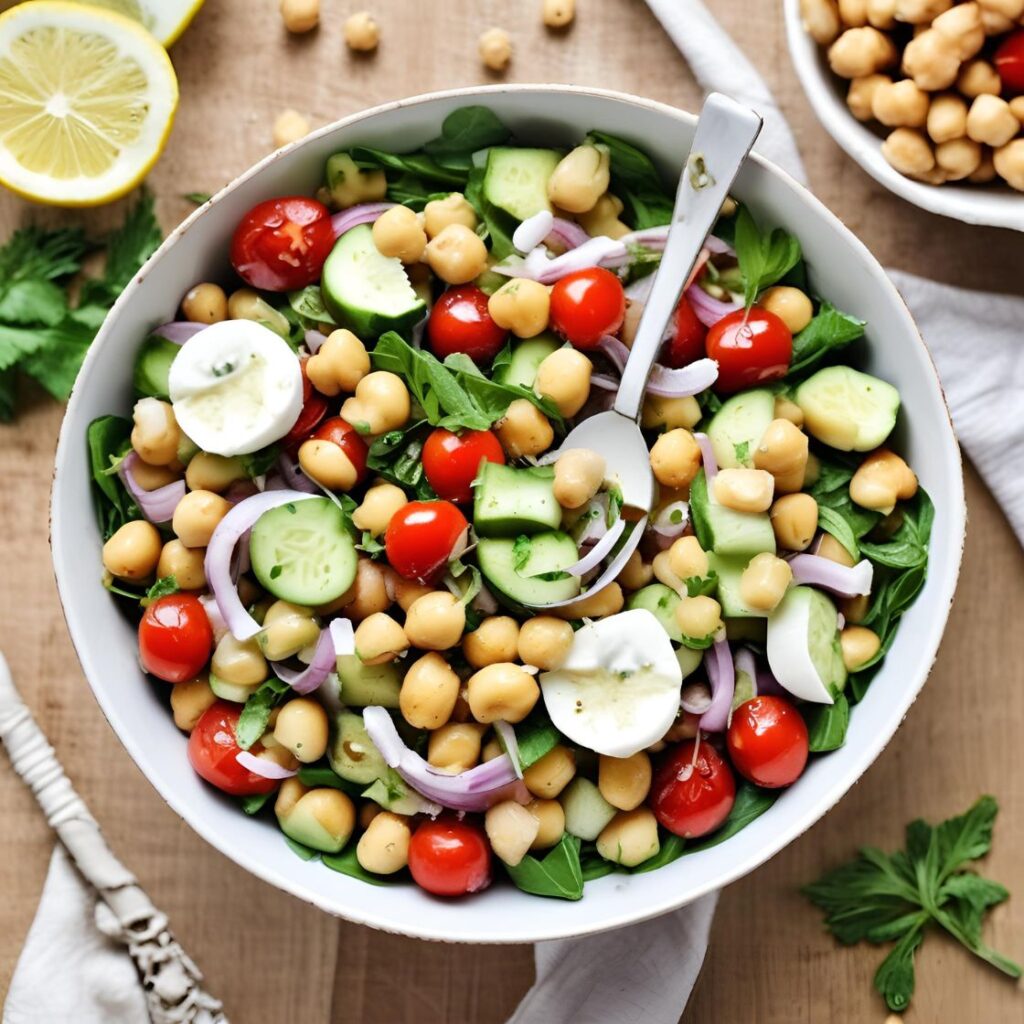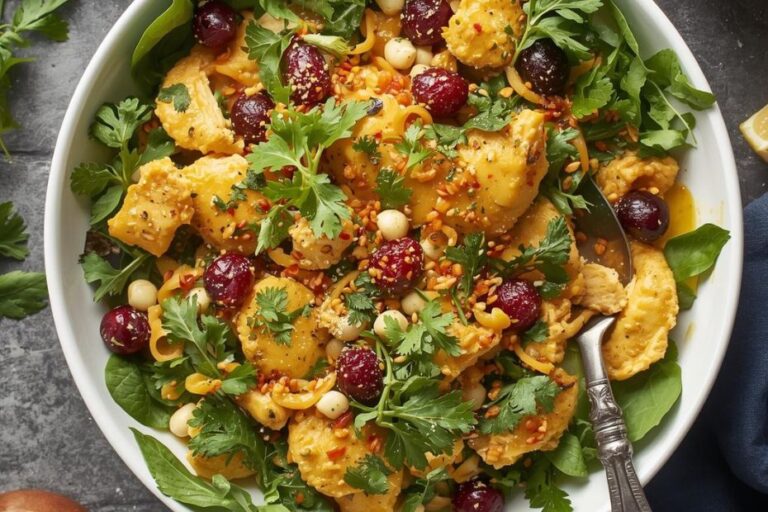Chickpea Mediterranean Salad Recipe: A Fresh Take on Classic Flavors
Walking through the vibrant markets of Athens last summer, you discovered how simple ingredients can create something extraordinary.
This chickpea Mediterranean salad captures that same magic, combining protein-rich legumes with sun-ripened vegetables, briny olives, and creamy feta cheese.
The preparation involves draining and rinsing canned chickpeas, then tossing them with diced cucumbers, cherry tomatoes, red onion, and a zesty lemon-herb dressing.
What makes this recipe special is the balance of textures and the way each ingredient maintains its distinct character while harmonizing with the others.
I recommend letting the salad rest for at least 30 minutes before serving to allow the flavors to meld together beautifully.
Quick Overview
| Detail | Time/Info |
|---|---|
| Prep Time | 15 minutes |
| Cook Time | 0 minutes |
| Total Time | 15 minutes |
| Course | Salad, Side Dish, Main Course |
| Cuisine | Mediterranean, Greek |
| Servings | 4-6 people |
Ingredients List
| Ingredient | 4 Servings | 6 Servings | 8 Servings | Alternatives |
|---|---|---|---|---|
| Canned chickpeas | 2 cans (15 oz each) | 3 cans (15 oz each) | 4 cans (15 oz each) | Dried chickpeas (soaked overnight) |
| Cherry tomatoes | 2 cups, halved | 3 cups, halved | 4 cups, halved | Regular tomatoes, diced |
| English cucumber | 1 large, diced | 1.5 large, diced | 2 large, diced | Regular cucumber (peeled) |
| Red onion | 1/2 medium, thinly sliced | 3/4 medium, thinly sliced | 1 medium, thinly sliced | Sweet onion, green onions |
| Feta cheese | 6 oz, crumbled | 9 oz, crumbled | 12 oz, crumbled | Goat cheese, ricotta salata |
| Kalamata olives | 1/2 cup, pitted | 3/4 cup, pitted | 1 cup, pitted | Green olives, mixed olives |
| Fresh parsley | 1/2 cup, chopped | 3/4 cup, chopped | 1 cup, chopped | Fresh dill, cilantro |
| Fresh oregano | 2 tbsp, chopped | 3 tbsp, chopped | 4 tbsp, chopped | Dried oregano (1 tsp) |
| Extra virgin olive oil | 1/4 cup | 6 tbsp | 1/2 cup | Avocado oil |
| Fresh lemon juice | 3 tbsp | 4 tbsp | 5 tbsp | Red wine vinegar |
| Garlic cloves | 3, minced | 4, minced | 5, minced | Garlic powder (1 tsp) |
| Sea salt | 1 tsp | 1.5 tsp | 2 tsp | Kosher salt |
| Black pepper | 1/2 tsp | 3/4 tsp | 1 tsp | White pepper |
Cooking Instruments Needed
| Tool | Alternative |
|---|---|
| Large mixing bowl | Large salad bowl |
| Fine mesh strainer | Colander |
| Sharp chef’s knife | Paring knife |
| Cutting board | Large plate |
| Small bowl for dressing | Mason jar with lid |
| Whisk | Fork |
| Measuring cups | Kitchen scale |
| Can opener | Pop-top cans |
How to Make Chickpea Mediterranean Salad
Lets go to the process.

Prepare the Chickpeas
Start by opening the canned chickpeas and draining them completely through a fine mesh strainer. Rinse the chickpeas under cold running water for about 30 seconds to remove excess sodium and the slightly viscous liquid from the can.
This step is important because it eliminates any metallic taste and creates a cleaner flavor profile for your salad. Shake the strainer gently to remove excess water, then transfer the chickpeas to a clean kitchen towel.
Pat them dry thoroughly, as removing moisture prevents the dressing from becoming watery later. Some people prefer to remove the skins from chickpeas for a more refined texture, though this is completely optional.
If you choose to do this, simply rub the dried chickpeas between your hands or with the towel, and the loose skins will come off easily.
Prepare the Vegetables
Begin with the cherry tomatoes by washing them under cold water and patting them dry. Cut each tomato in half, removing any that feel overly soft or have blemishes.
For the cucumber, wash it thoroughly and decide whether to peel it based on your preference.
English cucumbers have thin, tender skins that many people enjoy, while regular cucumbers might benefit from peeling.
Cut the cucumber into uniform dice, approximately the same size as the chickpeas, so each bite contains a balanced mix of ingredients.
The red onion requires special attention since raw onion can be quite pungent. Slice it as thinly as possible, almost paper-thin, which will make it more palatable and prevent it from overwhelming the other flavors.
If you find raw onion too sharp, you can soak the sliced onion in cold water for 10 minutes, then drain and pat dry.
Create the Herb Mixture
Fresh herbs make all the difference in this Mediterranean chickpea salad recipe. Start with the parsley by washing it thoroughly and spinning it dry in a salad spinner or patting it with paper towels.
Remove the tough stems, but don’t worry about every tiny stem, as they add good texture and flavor.
Chop the parsley roughly, aiming for pieces that are substantial enough to provide bursts of fresh flavor. The oregano should be handled more delicately since it has a stronger flavor. If using fresh oregano, strip the leaves from the stems and chop them finely.
The goal is to distribute the oregano evenly throughout the salad without creating any overwhelming pockets of intense flavor.
Some cooks prefer to bruise the herbs slightly by giving them a gentle press with the flat side of the knife, which helps release their essential oils.
Make the Dressing
In a small bowl, combine the minced garlic with the lemon juice first. This technique, called blooming, allows the garlic to mellow slightly and infuse the lemon juice with its flavor.
Let this mixture sit for about 5 minutes while you prepare other ingredients. Add the olive oil gradually while whisking continuously to create a proper emulsion.
The dressing should look slightly cloudy and hold together rather than separating immediately.
Season with salt and black pepper, tasting as you go. The acidity from the lemon juice should balance the richness of the olive oil, while the garlic provides a subtle bite that complements the other Mediterranean flavors.
Some cooks add a pinch of dried oregano or a small amount of Dijon mustard to the dressing for extra complexity, though the basic version is perfect as written.
Combine All Ingredients
In your large mixing bowl, combine the prepared chickpeas, halved cherry tomatoes, diced cucumber, and sliced red onion. Add the crumbled feta cheese, being careful not to break it up too much as you want substantial chunks in the final salad.
The olives should be added whole if they’re small, or cut in half if they’re particularly large. Pour the prepared dressing over the mixture and add the chopped fresh herbs.
Using clean hands or a large spoon, gently toss everything together, making sure the dressing coats all ingredients evenly.
The key is to be gentle enough that the feta doesn’t completely crumble and the tomatoes don’t break apart, but thorough enough that every component is well-coated with the herb-lemon dressing.
Final Assembly and Resting
Once everything is combined, taste the salad and adjust the seasoning as needed. You might want to add more lemon juice for brightness, more salt to bring out the flavors, or additional herbs for freshness.
Cover the bowl with plastic wrap or transfer to an airtight container and refrigerate for at least 30 minutes before serving. This resting time allows the flavors to meld together and the vegetables to release their juices slightly, creating a more cohesive and flavorful dish.
The salad actually improves with time, so making it a few hours ahead or even the night before can result in even better flavor development.
Serving and Decoration Tips
This chickpea Mediterranean salad shines when served in attractive ways that highlight its colorful ingredients.
Consider using a large, shallow serving bowl rather than a deep one, which allows guests to see all the beautiful components. For individual servings, small white or blue bowls echo the Mediterranean theme perfectly.
Garnish each serving with a few extra crumbles of feta cheese, a drizzle of good olive oil, and a sprinkle of fresh herbs. A few whole olives and cherry tomato halves arranged on top add visual appeal and signal the flavor profile to guests.
For outdoor entertaining, this salad works wonderfully as part of a mezze spread. Serve it alongside warm pita bread, hummus, and other Mediterranean favorites.
The salad can also be served over a bed of mixed greens for a more substantial meal, or stuffed into pita pockets for a portable lunch option.
When presenting the salad, consider the color contrast by using white or light-colored serving dishes that make the vibrant reds, greens, and creamy white feta pop.
Temperature matters significantly for this dish. Serve it slightly chilled but not ice-cold, as extreme cold can mute the flavors. Remove it from the refrigerator about 15 minutes before serving to allow it to come to the perfect temperature.
For special occasions, you might garnish with edible flowers like nasturtiums or herbs flowers, which add both beauty and a subtle peppery note that complements the Mediterranean flavors.
Variations to Try
The beauty of this chickpea Mediterranean salad recipe lies in its adaptability to different tastes and dietary needs.
- For a heartier version, add cooked quinoa or bulgur wheat, which transforms it into a more substantial grain salad.
- The addition of roasted red peppers brings sweetness and smokiness, while artichoke hearts contribute a tender, tangy element that pairs beautifully with the existing flavors.
- Protein variations can make this salad a complete meal. Grilled chicken, lamb, or shrimp work wonderfully, as does canned tuna or salmon for a quick weeknight dinner.
- For vegetarian protein boosts, try adding hemp seeds, sunflower seeds, or chopped hard-boiled eggs. Each addition changes the character of the salad while maintaining its Mediterranean roots.
- Seasonal variations keep the recipe interesting throughout the year. In spring, add fresh peas, asparagus, or radishes.
- Summer variations might include roasted zucchini, fresh corn, or additional tomato varieties.
- Fall versions can incorporate roasted butternut squash or pomegranate seeds, while winter adaptations might feature dried cranberries or chopped apples for sweetness. For those following specific dietary patterns, this recipe adapts easily.
- Vegan versions can substitute the feta with crumbled tofu, nutritional yeast, or a plant-based feta alternative.
- Low-carb adaptations might add more vegetables and reduce the chickpea quantity, while those seeking more fiber can add chopped celery, bell peppers, or fresh spinach.
Storing Tips
Proper storage extends the life of this chickpea Mediterranean salad and actually improves its flavor over time.
Store the salad in an airtight container in the refrigerator for up to four days. The flavors continue to develop and meld during storage, often making day-two salad taste even better than freshly made.
However, the texture will change slightly as the vegetables release moisture and the herbs wilt somewhat.
For optimal freshness, store the salad components separately if you’re making it more than a day ahead. Keep the dressed chickpeas and vegetables in one container, and add fresh herbs and feta cheese just before serving.
This prevents the herbs from becoming slimy and the feta from completely breaking down. If you notice excess liquid in the bottom of the container, simply drain it off before serving or stir it back in if you prefer a more saucy consistency.
Freezing is not recommended for this salad, as the high water content in the vegetables and the dairy in the feta cheese don’t freeze well.
The texture becomes mushy and unappetizing upon thawing. However, you can prepare and freeze the chickpeas separately if you’re batch-cooking, then thaw them and proceed with the fresh preparation when ready to make the salad.
For transportation to picnics or potlucks, pack the salad in a container with a tight-fitting lid and keep it chilled with ice packs.
The salad is actually perfect for outdoor dining since it doesn’t require heating and tastes best at cool room temperature.
Just remember to not leave it in the temperature danger zone for more than two hours for food safety reasons.
Extra Tips for Success
Temperature control plays a significant role in maximizing the flavor of this chickpea Mediterranean salad.
Ingredients should be at room temperature when you’re assembling the salad, as this allows the flavors to meld more effectively.
If your chickpeas and vegetables are cold from the refrigerator, let them sit out for 15-20 minutes before mixing with the dressing.
The quality of your olive oil makes a noticeable difference in the final product. Use the best extra virgin olive oil you can afford, as it’s one of the primary flavor components.
Similarly, fresh lemon juice is far superior to bottled, providing brighter acidity and more complex flavor notes.
When selecting lemons, choose those that feel heavy for their size and have smooth, thin skins.
Seasoning should be done gradually and with consideration for the saltiness of other ingredients.
Feta cheese and olives both contribute significant sodium, so start with less salt in the dressing and adjust after everything is combined.
Tasting throughout the process helps you understand how the flavors develop and balance.
For those who enjoy meal prep, this salad is excellent for batch cooking. Make a large batch on Sunday and portion it into individual containers for quick lunches throughout the week.
The flavors actually improve with time, making it one of those rare salads that doesn’t suffer from advance preparation.
Common Mistakes, Solutions & Prevention
| Common Mistake | Problem It Causes | Solution | Prevention |
|---|---|---|---|
| Not draining chickpeas properly | Watery, diluted dressing | Drain excess liquid, add more dressing | Rinse and pat dry thoroughly |
| Using poor quality olive oil | Bland, flat flavor | Replace with better oil and re-dress | Invest in good extra virgin olive oil |
| Cutting vegetables too large | Uneven bites, poor distribution | Re-cut vegetables to chickpea size | Aim for uniform, bite-sized pieces |
| Over-mixing the salad | Broken feta, mushy vegetables | Add fresh feta and herbs | Fold gently with hands or large spoon |
| Adding herbs too early | Wilted, slimy herbs | Add fresh herbs before serving | Add delicate herbs at the end |
| Not seasoning gradually | Too salty or bland salad | Balance with lemon juice or more vegetables | Taste and adjust throughout preparation |
| Using bottled lemon juice | Artificial, flat taste | Replace with fresh lemon juice | Always use fresh citrus |
| Serving immediately after mixing | Flavors not properly melded | Refrigerate for 30 minutes minimum | Plan ahead for resting time |
Chickpea Mediterranean Salad
A vibrant, protein-packed salad featuring tender chickpeas, crisp vegetables, creamy feta, and fresh herbs tossed in a zesty lemon dressing. Perfect for meal prep or entertaining.
Ingredients
- Chickpeas
- cherry tomatoes
- cucumber
- red onion
- feta cheese
- Kalamata olives
- fresh parsley
- oregano
- olive oil
- lemon juice
- garlic
- salt
- pepper
Instructions
Drain and rinse chickpeas, dice vegetables, prepare herb-lemon dressing, combine all ingredients, toss gently, refrigerate for 30 minutes before serving
Notes
Salad improves with time as flavors meld. Store up to 4 days refrigerated.
Frequently Asked Questions
Can I use dried chickpeas instead of canned for this chickpea Mediterranean salad? Absolutely! Dried chickpeas actually provide better texture and flavor control. Soak 1 cup of dried chickpeas overnight, then cook them in boiling salted water for 1-2 hours until tender.
This method allows you to control the salt content and achieve the perfect texture. Cook extra and freeze portions for future salads.
How do I prevent the red onion from overpowering the other flavors? Raw red onion can be quite sharp, but several techniques can mellow its bite. Slice it paper-thin and soak in cold water for 10-15 minutes, then drain and pat dry.
Alternatively, quick-pickle the sliced onion in lemon juice and a pinch of salt for 20 minutes. Some cooks prefer to use sweet onion or even green onions for a milder flavor profile.
What’s the best way to achieve restaurant-quality feta texture in this salad? The secret is in the feta selection and handling.
Choose block feta stored in brine rather than pre-crumbled versions, which tend to be drier and less flavorful. Pat the feta dry and crumble it by hand into irregular, bite-sized pieces.
Add it to the salad just before serving to maintain its creamy texture and prevent it from breaking down completely.
Can this salad be made ahead for meal prep, and how does it hold up? This salad is actually perfect for meal prep and often tastes better the next day.
Prepare everything except the fresh herbs and feta, then store in the refrigerator for up to 4 days. Add the herbs and feta just before serving to maintain optimal texture and fresh flavor.
The longer marinating time allows the flavors to develop beautifully.
What are some creative ways to serve this salad beyond a simple side dish? Transform this versatile salad into different meal formats: stuff it into pita pockets with additional greens, serve it over quinoa or rice for a grain bowl, use it as a topping for grilled fish or chicken, or serve it with crusty bread and additional olive oil for a light lunch.
It also works wonderfully as part of a mezze platter alongside hummus, olives, and warm flatbread.
Let’s Make and Share This Mediterranean Delight
This chickpea Mediterranean salad recipe brings together the best of healthy eating and satisfying flavors in one beautiful dish.
The combination of protein-rich chickpeas, fresh vegetables, and aromatic herbs creates a meal that nourishes both body and soul.
The beauty of this recipe lies in its simplicity and flexibility. Once you master the basic technique, you can adapt it to your personal preferences and seasonal availability.
Try it this week and share your experience in the comments below. Did you add any creative variations?
How did your family react to this fresh take on Mediterranean flavors? Your feedback helps build a community of home cooks who appreciate the simple pleasure of good food made with love.






